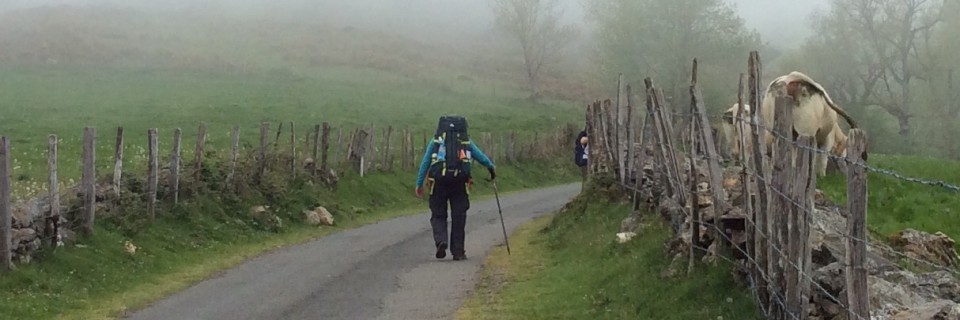A pilgrimage ends when the pilgrim returns home. Or it seems as if it should. Unlike so many long-ago pilgrims on the Camino whose pilgrimages ended abruptly beneath packs of wolves, or at the sword points of thieves, or from the illness called St. Anthony’s Fire, all of us but one arrived safely in Santiago. The pilgrim who didn’t make it had slipped on gravel on the second day of walking and broken her ankle. She was flown home after successful surgery in Pamplona.
The rest of us, having entered Santiago on foot, boarded planes and were home again in a little over twenty-four hours. It was a swift end to a short pilgrimage.
But I don’t feel as if things are wrapped up. I didn’t leave home with questions for which I was seeking answers, or with any particular burdens I wanted to leave on the Camino, unless it was all the burdens anyone accumulates over a lifetime: family legacies, even from happy families, that you realize too late have been extra weight on your back; all the wrong choices you have made; the sadness you could have avoided and the sadness you could not.
So my pilgrimage remains unresolved, open-ended. In fact, the longer I spent on the Camino, the more open-ended it became, a path running through Santiago and out to Finisterra, “Land’s End,” and beyond.
Some days on, I still feel the lack of certain things that had already become part of my life: the flecha amarilla, the yellow arrow, which has disappeared from the streets I walk here; lacing up my boots; hoisting my backpack first onto my right shoulder, then my left. Having barely begun to slip into it, I already miss the rhythm of walking.
I miss the camaraderie of my pilgrim group. For reasons of privacy I haven’t written much about it, but my fellow pilgrims were part of my Camino. We were a kind of school outing or Episcopalian camp for adults, who were called to attention by someone (usually, but not always, our leader) shouting “The Lord be with you!”, which elicited an immediate, Book of Common Prayer (Rite II) chorus of “And also with you!” Each morning we claimed our habitual spots on the bus. We traded that day’s updates on aches and pains, packing strategies, dietary complaints. We drank a lot of wine, and we laughed a lot. Walking on the Camino we strung out according to our individual paces and gaits and then came together again at the meeting point, like a spool of thread that unwinds and is rolled up again.
We celebrated Eucharist with a makeshift chalice and paten, with bread saved from lunch, with wine someone had dashed into a store to purchase. We celebrated it just inside the walls of Ávila, with curious schoolchildren looking on, on an old stone bridge in Santo Domingo de Silos, and on the beach at Finisterra. We also lit Shabbat candles on two Friday evenings; our group included a Reform rabbi interested in interfaith spirituality and her son. If “the Lord be with you” was intoned often, at these two quiet hinges between the week and the Sabbath came the words Baruch atah Adonai … .
On the last walking day, on the ridge above Portomarín, I came abreast of a pilgrim from Orange County, California, a trim man in late middle age with an accent I took to be Vietnamese. It was not his first Camino. I explained, somewhat apologetically, that I was with a group and had walked only portions of the Camino. He smiled faintly and said, “The Camino will haunt you.”
I am fairly certain he was right. What I’m uncertain of still is where it might lead.


Wonderful. Love this metaphor, “… like a spool of thread that unwinds and is rolled up again….”
May your camino continue to inspire your life and relationship woth The More.
Peace,
v
I feel as if managing to write these blog post (often on the bus) was .
Being able to write the posts was, I think, a gift from God by way of The Way.